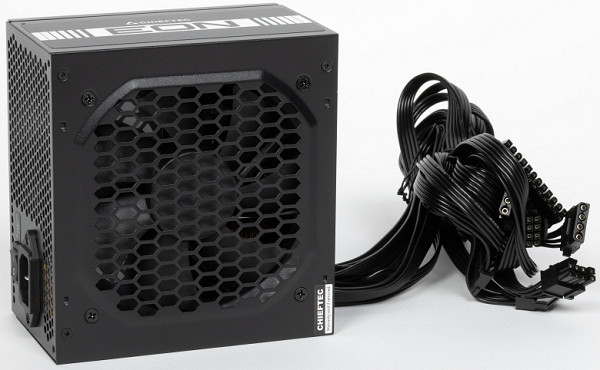
We continue our series of articles about budget power supplies. This time we will review the Chieftec EON 600W (ZPU-600S) power supply unit, which is one of the senior models in the EON series from this manufacturer (700, 500 and 400 W versions are also available). At the time of publication of the review, the retail price of the power supply unit was $67. Chieftec offers many models in this segment, but not all of them are equally effective.
The power supply unit case is painted black, which, together with the packaging, emphasizes its belonging to the retail segment of the market. The dimensions of the power supply unit are standard, the length of the case is 140 mm.
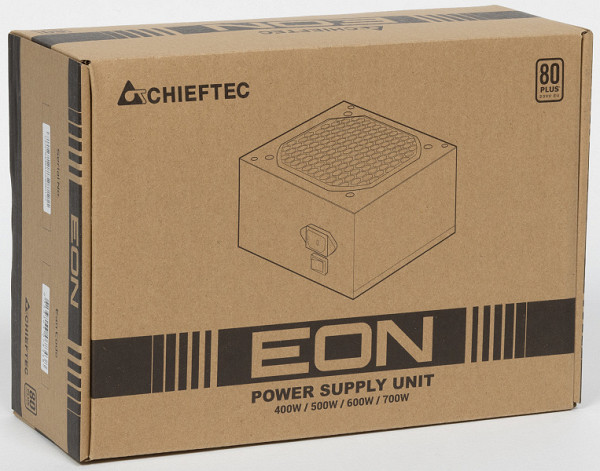
This model comes in a simple unpainted cardboard box with monochrome printing.
Characteristics
All the necessary parameters are indicated on the power supply housing, including the declared +12VDC bus power of 540 W. The ratio of the +12VDC bus power to the total power is 0.9, which is a good indicator for a budget solution.
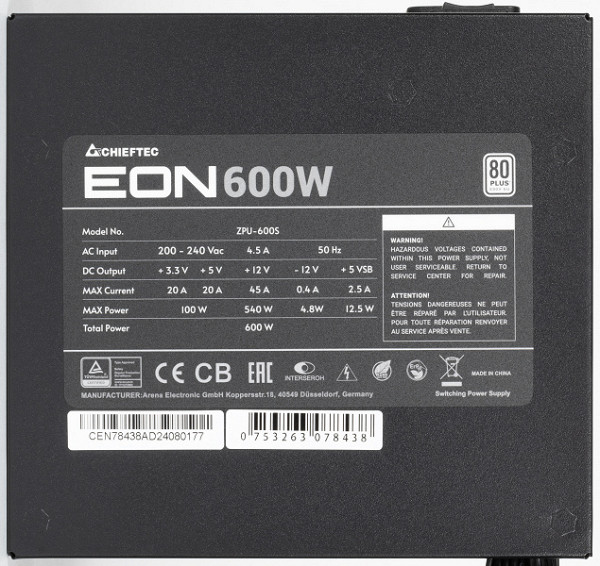
Wires and connectors

| Name of the connector | Number of connectors | Notes |
|---|---|---|
| 24 pin Main Power Connector | 1 | collapsible |
| 4 pin 12V Power Connector | — | |
| 8 pin SSI Processor Connector | 2 | collapsible |
| 6 pin PCI-E 1.0 VGA Power Connector | — | |
| 8 pin PCI-E 2.0 VGA Power Connector | 2 | on one cord |
| 4 pin Peripheral Connector | 2 | on two cords |
| 15 pin Serial ATA Connector | 4 | on two cords |
| 4 pin floppy drive connector | — |
Length of wires to power connectors
- 1 cord: to the main ATX connector — 63 cm
- 1 cord: to the 8-pin SSI processor connector — 70 cm, plus another 10 cm to the second connector (about 78 cm to the last connector)
- 1 cord: to the first PCIe 2.0 VGA Power Connector — 55 cm, plus another 15 cm to the second connector
- 2 cords: to the first SATA Power Connector — 45 cm, plus 15 cm to the second connector, plus another 15 cm to the Peripheral Connector (Molex)
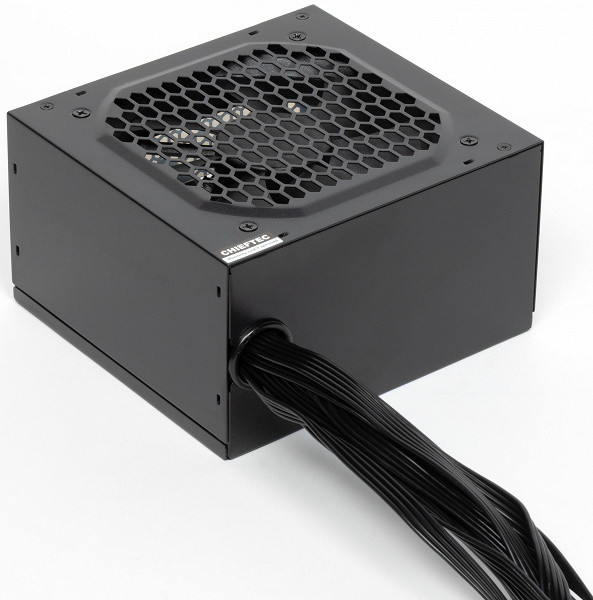
The length of the power supply cables is sufficient for comfortable use in full tower cases and larger ones with the PSU placed on top. In cases up to 55 cm high with the PSU placed on the bottom, the length of the cables should also be suitable, since the processor power cord reaches almost 80 cm. Thus, the power supply should be compatible with most modern cases.
All cables are fixed, which is typical for budget models, but their number is not too large, so they will not interfere too much in the case.
A positive aspect is the presence of straight SATA connectors, which simplifies the connection of drives located on the back of the motherboard base or in other hard-to-reach places.
However, the distribution of connectors along the power cords is not ideal. Fully connecting several devices can be difficult, especially if you need to connect over long distances, and only four SATA Power connectors may not be enough. However, for a typical system with a couple of drives, there should be no problems.
The advantage is the use of ribbon cables, which simplify assembly and operation.
This 600W PSU has only two power connectors for graphics cards, and both are on a single cord, which limits its ability to work with high-power graphics cards. However, for a single mid-range graphics card, even with a demanding processor, this PSU is quite suitable.
Circuitry and cooling
The power supply is equipped with an active power factor corrector, but has a standard rather than an extended supply voltage range.
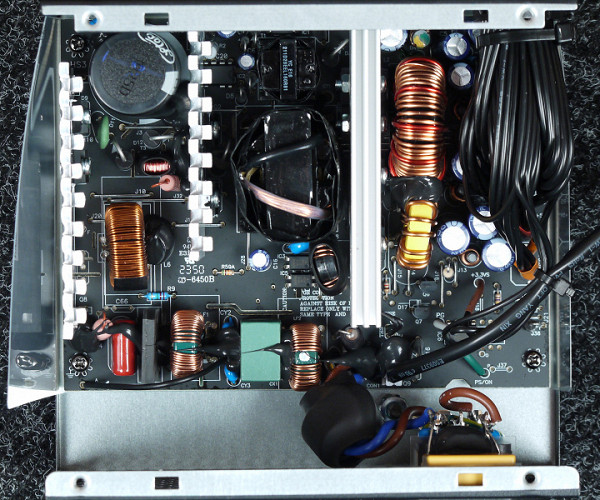
The main semiconductor elements of the power supply are mounted on three small radiators: the first one houses the power factor corrector elements, the second one houses the main AC inverter elements, and the third one houses the rectifiers.
The power supply is based on the CWT platform, which is not the most modern one. Group stabilization is implemented for the +5VDC and +12VDC channels, as well as +3.3VDC, which is controlled by a separate stabilizer based on a magnetic amplifier. This is typical for budget solutions.
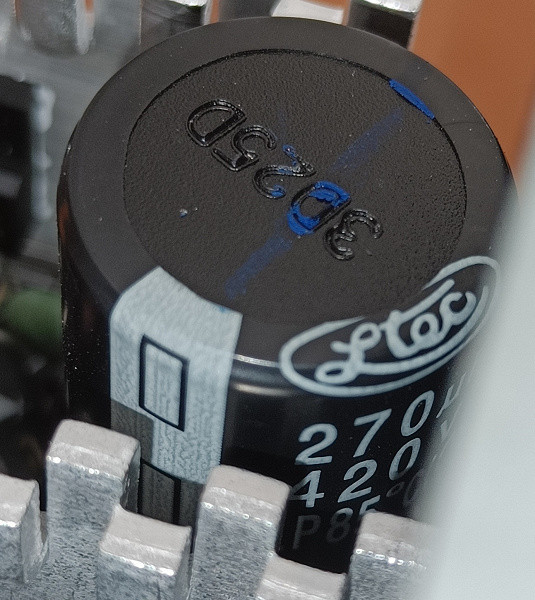

At the input, a capacitor under the Ltec brand is installed. In low-voltage circuits, capacitors under the Jun Fu brand are predominant.
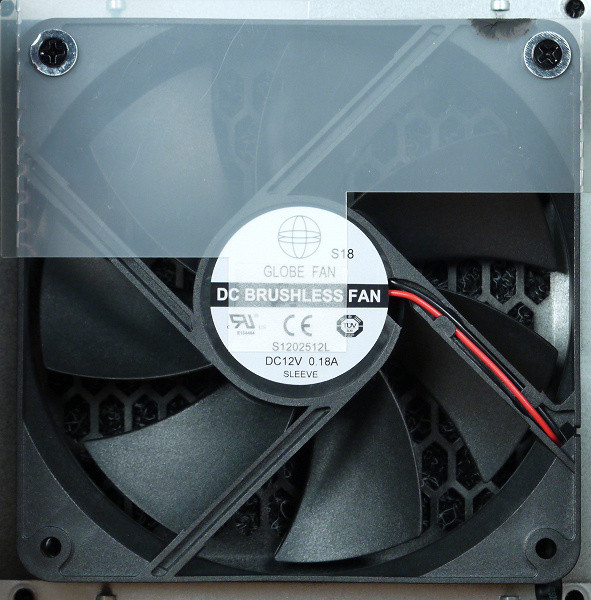
The power supply unit is equipped with a Globe Fan S1202512L 120mm fan, partially covered by a plastic deflector to improve airflow direction. The fan uses a sleeve bearing and has a two-wire plug connection, which makes it easy to replace. It should work without problems during the warranty period.
Measuring electrical characteristics
Now we move on to measuring the electrical characteristics of the power supply using a multi-function stand and other equipment.
Deviations of output voltages from nominal values will be indicated by colors as follows:
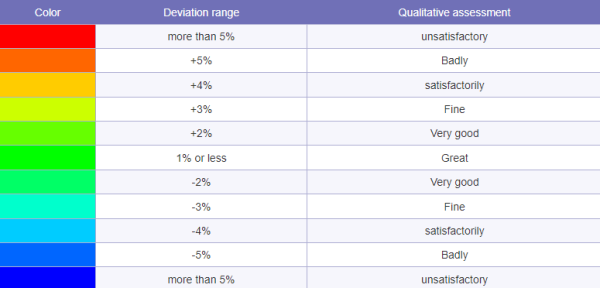
Working at maximum power
The first stage of testing is to operate the power supply at maximum power for a long time. This test allows you to confidently check its functionality. In this case, we conducted several tests to avoid problems with overheating of the connectors, given their small number.
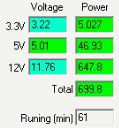
The power supply is indeed capable of operating at its maximum declared power for a long time. However, in a real system, achieving this power will be difficult due to the limited number of video card power connectors and the impossibility of significantly loading the +3.3VDC and +5VDC channels.
Cross-load characteristic
The next stage of instrumental testing is the construction of a cross-load characteristic (CLC), which is presented on a graph, where one axis (ordinate) displays the maximum power on the 3.3V and 5V buses, and the other axis (abscissa) displays the maximum power on the 12V bus. At each point of the graph, the measured voltage value is indicated by a color marker reflecting the deviation from the nominal value.

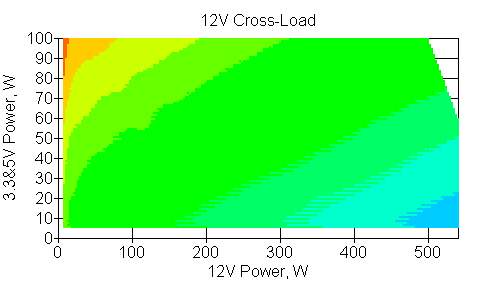
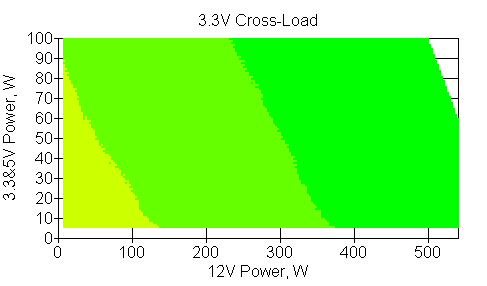
The cross-load characteristic (CLC) allows you to determine the permissible load level, especially for the +12VDC channel, for the tested power supply. In this case, the voltage deviations on the +5VDC channel exceed 5% with a total load power on the +3.3VDC and +5VDC channels of less than 20 W.
With a typical power distribution across channels, deviations from the nominal value do not exceed 3% with a load power of about 450 W on the +12VDC channel. However, deviations on the +5VDC channel are more than 5%, exceeding the nominal values.
Such behavior is often observed in power supplies with group stabilization, and this model is no exception.
Load capacity
The following test is designed to determine the maximum power that can be supplied through the connectors while maintaining a voltage tolerance of 3 or 5 percent of the nominal value.

For a video card with one power connector, the maximum power on the +12VDC channel is at least 90 W with a voltage deviation of 3% and at least 150 W with a deviation of 5%.

In case of a video card with two power connectors, the maximum power on the +12VDC channel is at least 250 W with a deviation of 3%.

When loaded via the processor power connector, the maximum power on the +12VDC channel is at least 250 W with a deviation of 3%, which is quite sufficient for budget systems.

For a motherboard, the maximum power on the +12VDC rail is at least 150W with a tolerance of 3%. Since the board itself draws about 10W on this rail, high power may be needed to power expansion cards such as graphics cards without an additional power connector, which typically draw about 75W.
Economy and efficiency
There are two approaches to evaluating the efficiency of a computer power supply. The first is to analyze the power supply as a separate converter of electrical energy in order to minimize the resistance of the transmission line from the power supply to the load, where the measurements are taken. Typically, the power supply is connected using all available connectors, which creates an unequal environment for different models, since the number and type of connectors may differ even for power supplies of the same wattage. Although such results are accurate for each specific power supply, they have limited applicability in real-world conditions, where only the required number of connectors are used.
An alternative approach is to evaluate the efficiency at fixed wattages and with a specific set of connectors, which more realistically reflects the use of the power supply in real systems.
The efficiency of a power supply measures the ratio of output to input power, which reflects the efficiency of energy conversion. Although high efficiency is usually associated with greater economy and quality, it does not affect system performance, noise, or temperature inside the case. Efficiency has become an important marketing tool, especially when combined with 80Plus certification. In practice, increasing efficiency can increase the cost of a power supply, which is not always justified for the user.
To objectively evaluate the efficiency of a power supply, you should take into account the dissipated power (the difference between the input and output power) and energy consumption over a certain period of time (e.g., a day, month, year) under a constant load. This allows you to see the real difference in energy consumption between power supply models and calculate the economic benefit of using more expensive and efficient models.
For ease of calculation, you can use the dissipated power in kilowatt-hours (kW h), which makes it easy to determine the cost of consumed electricity. By multiplying this value by the cost of kW h, you can calculate the cost of electricity for 24-hour operation of the system during the year. This is a hypothetical example, but it helps to evaluate the difference in the cost of operating a computer with different power supplies and decide on the feasibility of purchasing them.
We will offer several typical options for power supplies by power and correlate them with the number of connectors so that the efficiency measurement method is closer to real operating conditions. This will allow you to objectively compare the efficiency of different power supplies under the same conditions.
| Load via connectors | 12VDC, W | 5VDC, W | 3.3VDC, W | Total power, W |
|---|---|---|---|---|
| Main ATX, CPU (12V), SATA | 5 | 5 | 5 | 15 |
| Main ATX, CPU (12V), SATA | 80 | 15 | 5 | 100 |
| Main ATX, CPU (12V), SATA | 180 | 15 | 5 | 200 |
| Main ATX, CPU (12V), 6-pin PCIe, SATA | 380 | 15 | 5 | 400 |
| Main ATX, CPU (12V), 6-pin PCIe (1 cable with 2 connectors), SATA | 480 | 15 | 5 | 500 |
| Main ATX, CPU (12V), 6-pin PCIe (2 cables with 1 connector), SATA | 480 | 15 | 5 | 500 |
| Main ATX, CPU (12V), 6-pin PCIe (2 cables with 2 connectors), SATA | 730 | 15 | 5 | 750 |
The results obtained are as follows:
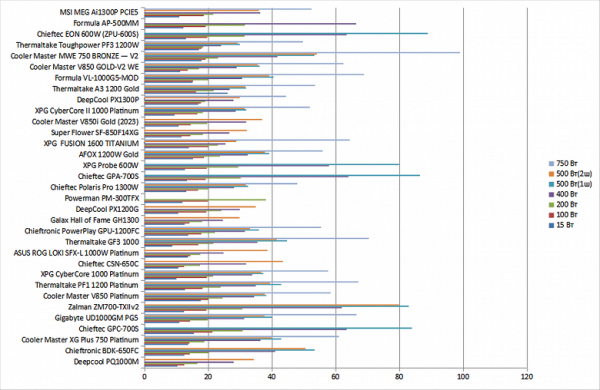
| Dissipated power, W | 15 W | 100 W | 200 W | 400 W | 500 W (1 cord) | 500W (2 cords) | 750 W |
|---|---|---|---|---|---|---|---|
| Cougar BXM 700 | 12.0 | 18.2 | 26.0 | 42.8 | 57.4 | 57.1 | |
| Cooler Master Elite 600 V4 | 11.4 | 17.8 | 30.1 | 65.7 | 93.0 | ||
| Cougar GEX 850 | 11.8 | 14.5 | 20.6 | 32.6 | 41.0 | 40.5 | 72.5 |
| Cooler Master V650 SFX | 7.8 | 13.8 | 19.6 | 33.0 | 42.4 | 41.4 | |
| Chieftec BDF-650C | 13.0 | 19.0 | 27.6 | 35.5 | 69.8 | 67.3 | |
| XPG Core Reactor 750 | 8.0 | 14.3 | 18.5 | 30.7 | 41.8 | 40.4 | 72.5 |
| Deepcool DQ650-M-V2L | 11.0 | 13.8 | 19.5 | 34.7 | 44.0 | ||
| Deepcool DA600-M | 13.6 | 19.8 | 30.0 | 61.3 | 86.0 | ||
| Fractal Design Ion Gold 850 | 14.9 | 17.5 | 21.5 | 37.2 | 47.4 | 45.2 | 80.2 |
| XPG Pylon 750 | 11.1 | 15.4 | 21.7 | 41.0 | 57.0 | 56.7 | 111,0 |
| Chieftronic PowerUp GPX-850FC | 12.8 | 15.9 | 21.4 | 33.2 | 39.4 | 38.2 | 69.3 |
| MSI MPG A750GF | 11.5 | 15.7 | 21.0 | 30.6 | 39.2 | 38.0 | 69.0 |
| Chieftronic PowerPlay GPU-850FC | 12.0 | 15.9 | 19.7 | 28.1 | 34.0 | 33.3 | 56.0 |
| Cooler Master MWE Gold 750 V2 | 12.2 | 16.0 | 21.0 | 34.6 | 42.0 | 41.6 | 76.4 |
| XPG Pylon 450 | 12.6 | 18.5 | 28.4 | 63.0 | |||
| Chieftronic PowerUp GPX-550FC | 12.2 | 15.4 | 21.6 | 35.7 | 47.1 | ||
| Chieftec BBS-500S | 13.3 | 16.3 | 22.2 | 38.6 | |||
| Cougar VTE X2 600 | 13.3 | 18.3 | 28.0 | 49.3 | 64.2 | ||
| Thermaltake GX1 500 | 12.8 | 14.1 | 19.5 | 34.8 | 47.6 | ||
| Thermaltake BM2 450 | 12.2 | 16.7 | 26.3 | 57.9 | |||
| Super Flower SF-750P14XE | 14.0 | 16.5 | 23.0 | 35.0 | 42.0 | 44.0 | 76.0 |
| XPG Core Reactor 850 | 9.8 | 14.9 | 18.1 | 29.0 | 38.4 | 37.0 | 63.0 |
| Asus TUF Gaming 750B | 11.1 | 13.8 | 20.7 | 38.6 | 50.7 | 49.3 | 93.0 |
| Chieftronic BDK-650FC | 12.6 | 14.3 | 20.4 | 41.1 | 53.5 | 50.6 | |
| Cooler Master XG Plus 750 Platinum | 13.8 | 14.2 | 18.9 | 36.5 | 43.0 | 40.0 | 61.1 |
| Chieftec GPC-700S | 15.6 | 21.4 | 30.9 | 63.5 | 84.0 | ||
| Zalman ZM700-TXIIv2 | 12.5 | 19.5 | 30.8 | 62.0 | 83.0 | 80.0 | |
| Cooler Master V850 Platinum | 17.8 | 20.1 | 24.6 | 34.5 | 38.3 | 37.8 | 58.5 |
| Chieftec CSN-650C | 10.7 | 12.5 | 17.5 | 32.0 | 43.5 | ||
| Powerman PM-300TFX | 12.0 | 20.0 | 38.2 | ||||
| Chieftec GPA-700S | 13.4 | 19.3 | 30.3 | 64.1 | 86.5 | ||
| XPG Probe 600W | 12.8 | 19.6 | 29.5 | 58.0 | 80.0 | ||
| Super Flower Leadex VII XG 850W | 11.7 | 14.5 | 18.4 | 26.7 | 32.2 | ||
| Cooler Master V850 Gold i Multi | 10.8 | 14.6 | 19.8 | 32.0 | 37.0 | ||
| Cooler Master V850 Gold V2 WE | 11.3 | 13.6 | 17.2 | 29.0 | 36.2 | 35.6 | 62.5 |
| Cooler Master MWE 750 Bronze V2 | 18.0 | 19.3 | 23.2 | 41.8 | 53.4 | 54.2 | 99.1 |
| Chieftec EON 600W (ZPU-600S) | 13.1 | 19.8 | 31.5 | 63.5 | 89.0 | ||
| Formula AP-500MM | 12.3 | 19.3 | 31.6 | 66.5 | |||
| Zalman GigaMax III 750W | 11.5 | 15.6 | 23.0 | 45.0 | 59.3 | 58.5 | 118.5 |
This model has relatively low efficiency in all tested modes; it is a typical representative of budget-segment power supplies, where efficiency is not the most important thing.
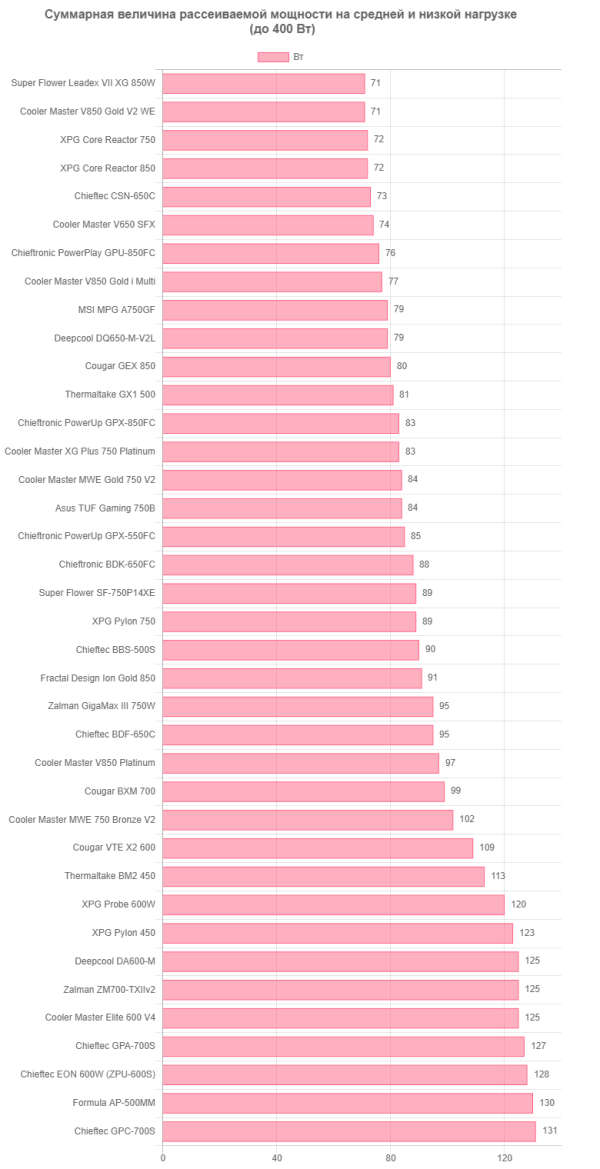
In terms of the total amount of dissipated power at medium and low loads, this model takes the honorable third place from the bottom among power supplies with a power of less than a kilowatt. At a load of 500 W, it is the second place from the bottom in the same rating.
| Energy consumption of a computer per year, kW h | 15 W | 100 W | 200 W | 400 W | 500 W (1 cord) | 500W (2 cords) | 750 W |
|---|---|---|---|---|---|---|---|
| Cougar BXM 700 | 237 | 1035 | 1980 | 3879 | 4883 | 4880 | |
| Cooler Master Elite 600 V4 | 231 | 1032 | 2016 | 4080 | 5195 | ||
| Cougar GEX 850 | 235 | 1003 | 1933 | 3790 | 4739 | 4735 | 7205 |
| Cooler Master V650 SFX | 200 | 997 | 1924 | 3793 | 4751 | 4743 | |
| Chieftec BDF-650C | 245 | 1042 | 1994 | 3815 | 4991 | 4970 | |
| XPG Core Reactor 750 | 202 | 1001 | 1914 | 3773 | 4746 | 4734 | 7205 |
| Deepcool DQ650-M-V2L | 228 | 997 | 1923 | 3808 | 4765 | ||
| Deepcool DA600-M | 251 | 1049 | 2015 | 4041 | 5133 | ||
| Fractal Design Ion Gold 850 | 262 | 1029 | 1940 | 3830 | 4795 | 4776 | 7273 |
| XPG Pylon 750 | 229 | 1011 | 1942 | 3863 | 4879 | 4877 | 7542 |
| Chieftronic PowerUp GPX-850FC | 244 | 1015 | 1940 | 3795 | 4725 | 4715 | 7177 |
| MSI MPG A750GF | 232 | 1014 | 1936 | 3772 | 4723 | 4713 | 7174 |
| Chieftronic PowerPlay GPU-850FC | 237 | 1015 | 1925 | 3750 | 4678 | 4672 | 7061 |
| Cooler Master MWE Gold 750 V2 | 238 | 1016 | 1936 | 3807 | 4748 | 4744 | 7239 |
| XPG Pylon 450 | 242 | 1038 | 2001 | 4056 | |||
| Chieftronic PowerUp GPX-550FC | 238 | 1011 | 1941 | 3817 | 4793 | ||
| Chieftec BBS-500S | 248 | 1019 | 1947 | 3842 | |||
| Cougar VTE X2 600 | 248 | 1036 | 1997 | 3936 | 4942 | ||
| Thermaltake GX1 500 | 244 | 1000 | 1923 | 3809 | 4797 | ||
| Thermaltake BM2 450 | 238 | 1022 | 1982 | 4011 | |||
| Super Flower SF-750P14XE | 254 | 1021 | 1954 | 3811 | 4748 | 4765 | 7236 |
| XPG Core Reactor 850 | 217 | 1007 | 1911 | 3758 | 4716 | 4704 | 7122 |
| Asus TUF Gaming 750B | 229 | 997 | 1933 | 3842 | 4824 | 4812 | 7385 |
| Chieftronic BDK-650FC | 242 | 1001 | 1931 | 3864 | 4849 | 4823 | |
| Cooler Master XG Plus 750 Platinum | 252 | 1000 | 1918 | 3824 | 4757 | 4730 | 7105 |
| Chieftec GPC-700S | 268 | 1064 | 2023 | 4060 | 5116 | ||
| Zalman ZM700-TXIIv2 | 241 | 1047 | 2022 | 4047 | 5107 | 5081 | |
| Cooler Master V850 Platinum | 287 | 1052 | 1968 | 3806 | 4716 | 4711 | 7083 |
| Chieftec CSN-650C | 225 | 986 | 1905 | 3784 | 4761 | ||
| Powerman PM-300TFX | 237 | 1051 | 2087 | ||||
| Chieftec GPA-700S | 249 | 1045 | 2017 | 4066 | 5138 | ||
| XPG Probe 600W | 244 | 1048 | 2010 | 4012 | 5081 | ||
| Super Flower Leadex VII XG 850W | 234 | 1003 | 1913 | 3738 | 4662 | ||
| Cooler Master V850 Gold i Multi | 226 | 1004 | 1925 | 3784 | 4704 | ||
| Cooler Master V850 Gold V2 WE | 230 | 995 | 1903 | 3758 | 4697 | 4692 | 7118 |
| Cooler Master MWE 750 Bronze V2 | 289 | 1045 | 1955 | 3870 | 4848 | 4855 | 7438 |
| Chieftec EON 600W (ZPU-600S) | 246 | 1049 | 2028 | 4060 | 5160 | ||
| Formula AP-500MM | 239 | 1045 | 2029 | 4087 | |||
| Zalman GigaMax III 750W | 232 | 1013 | 1954 | 3898 | 4900 | 4893 | 7608 |
Temperature conditions
In this case, the thermal load of the capacitors is at a low level throughout the entire power range, which can be assessed positively.
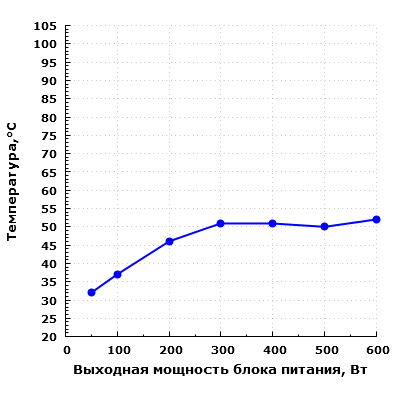
Acoustic ergonomics
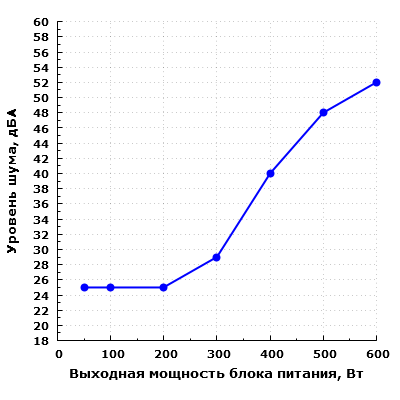
At a load of up to 200 W inclusive, the noise level of the power supply is about 25 dBA at a distance of 0.35 meters, which is considered low for a residential area during the day.
When operating at 300 W, the noise remains at a reduced level, suitable for daytime in residential areas. However, as the load increases, the noise level increases significantly.
At a load of 400 W, the noise of the power supply exceeds 40 dBA when placed on a table, which can already be called a fairly high noise level.
At a maximum power of 600 W, the noise level reaches 52 dBA, which is very high and creates significant discomfort in a home environment.
Thus, to ensure a comfortable acoustic environment, this model of the power supply is most effective with an output power of up to 300 W.
The noise level of the power supply electronics was also assessed, since in some cases it can cause unwanted overtones. Testing was carried out by measuring the difference in noise levels in the laboratory with the power supply on and off. If the difference does not exceed 5 dBA, no deviations in acoustic properties are detected. If the difference is more than 10 dBA, there are usually obvious defects that can be heard at a distance of about half a meter. The sound level meter microphone was placed at a distance of 40 mm from the upper plane of the power supply for measurement accuracy. Testing was carried out in two modes: standby (STB) and under load, but with the fan stopped.
In standby mode, electronic noise is practically absent, the excess of background noise is no more than 2 dBA, which can be considered relatively low.
Consumer qualities
The acoustic ergonomics of the Chieftec EON 600W power supply are quite good: it works quietly up to 200 W, and noticeable noise appears only at a load of 400 W, which is typical for budget models. In this sense, the optimal use of the power supply is in systems with a consumption of up to 300 W.
The load capacity of the +12VDC channel and the individual capacity of the channel for video cards in the power supply meet the requirements, but the +5VDC channel can cause problems, although it is rarely used in modern systems. The wires are long enough, but the set of connectors can be called not quite optimal.
Results
Chieftec EON 600W copes well with powering entry-level system units with a power of up to 300 W and even higher, if the user does not mind significant fan noise. In general, the power supply has proven its reliability and performance under long-term high loads, which is a positive point. However, it should be remembered that this is an extremely budget product, and it has its own features and disadvantages.
